EXCAVATION AREA
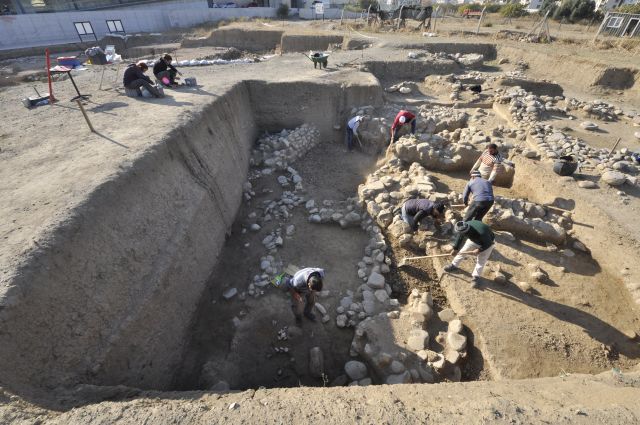
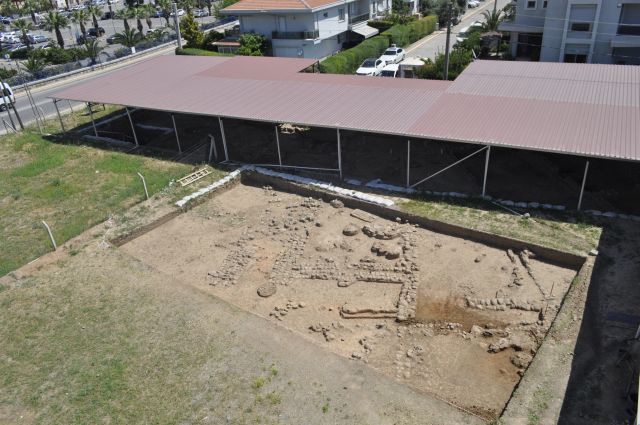
The Excavation
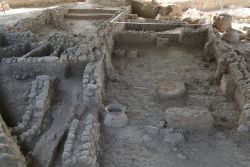 Yeşilova Höyük is the oldest settlement area in Izmir. Before it was discovered in 2003, Izmir's history was thought to base on 5000 years ago but after the discovery of Yeşilova and the findings found in excavations, Izmir got a reputation as one of the oldest settlement area in Western Anatolia . The excavation was started in 2005 after a one year break, in 2008 on behalf of Culture and Tourism Ministry and Ege University , excavation was restarted with the leadership of Ass.Prof. Dr. Zafer Derin.
Yeşilova Höyük is the oldest settlement area in Izmir. Before it was discovered in 2003, Izmir's history was thought to base on 5000 years ago but after the discovery of Yeşilova and the findings found in excavations, Izmir got a reputation as one of the oldest settlement area in Western Anatolia . The excavation was started in 2005 after a one year break, in 2008 on behalf of Culture and Tourism Ministry and Ege University , excavation was restarted with the leadership of Ass.Prof. Dr. Zafer Derin.
Mound settlement, located under 0,80 m of Bornova that surrended by mountains except its western part leaning to sea, has 3- 4 m of thickness. In surface of the mound, except late Roma keramik, nothing was found.
Mound is in the middle of Bornova plain and in the meeting point of Gökdere and Manda Brook. Settlement area is 4- 5 km away from the today's settlement area.It is thought that settlement area includes 200-300m area
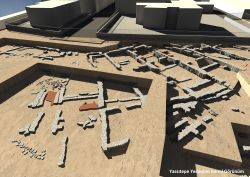 The cultural history of Izmir has had to be re-defined in the light of the discoveries of Yeşilova Höyük. It becomes more plausible to advance that the ancient culture of Izmir had been shaped by residents who had lived some 8000-9000 years ago, rather than by those who inhabited the Bayraklı Höyük as of the 3rd millenium B.C. Yeşilova Höyük is the birth-place of Izmir, and Bornova plain constituted the habitat of early settlers for a few thousand years. The two adjacent mounds of Bornova plain (Yeşilova and Yassıhöyük) initiated sedentary life in Izmir, and sedentarization gained a further impetus later with the Old Smyrna mound dating from the 3rd millenium B.C. The culture had developped on the basis of all of these sites.
The cultural history of Izmir has had to be re-defined in the light of the discoveries of Yeşilova Höyük. It becomes more plausible to advance that the ancient culture of Izmir had been shaped by residents who had lived some 8000-9000 years ago, rather than by those who inhabited the Bayraklı Höyük as of the 3rd millenium B.C. Yeşilova Höyük is the birth-place of Izmir, and Bornova plain constituted the habitat of early settlers for a few thousand years. The two adjacent mounds of Bornova plain (Yeşilova and Yassıhöyük) initiated sedentary life in Izmir, and sedentarization gained a further impetus later with the Old Smyrna mound dating from the 3rd millenium B.C. The culture had developped on the basis of all of these sites.
*The finds indicate that production industries for stone tools, instruments and other goods was developped. These tools, most of which was carved out of flintstone, came in various types such as arrowheads, blades, flakes, scrapers, borers.
The early C14 results for Yeşilova Höyük were obtained from the layer IV.7. These results point at a date value of 6500 BC . Layer IV.8 finds indicate that these dates may reach back for at least 200-300 years.
In the light of the above, it becomes necessary to re-evaluate the chronology of the Neolithic period for Turkey's Aegean Region, and re-examine the relations between this region and other regions. Because these finds indicate that the Neolithic period in Turkey's Aegean Region had started, as it was the case for Turkey's Lake Region (Isparta), prior to 6500 BCE, and that the same cultural process was pursued without interruption until the years 5700-5600 BCE.
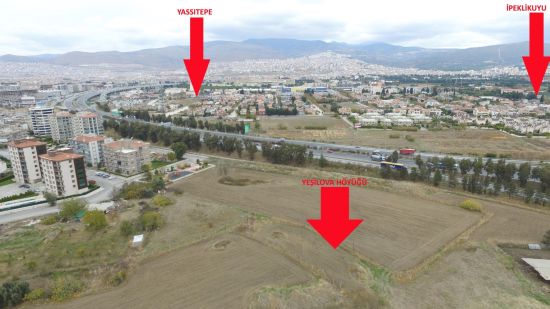
Yeşilova Höyüğü
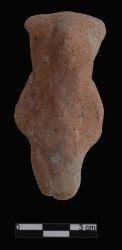
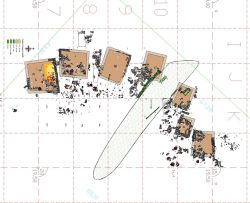 The settlement in Yeşilova Höyük consisted in 4 cultural layers. In partance of the surface, these layers correspond to the respective levels below;
The settlement in Yeşilova Höyük consisted in 4 cultural layers. In partance of the surface, these layers correspond to the respective levels below;
Ist Layer Late Roman period
IInd Layer Bronze Age
IIIrd Layer (Levels 1-2) Calcolithic period (Level 1:4340-4230B.C.)
IVth Layer (Levels 1a,b,c-8) Neolithic Period ; 6500BC.
First settlements in the Höyük began during the Neolithic Age, at least 8-9 thousand years before our time. The IVth layer is the longest standing and thickest cultural layer of the Yesilova Höyük. It is known that is process, which has 15 architectural layers that is thought to be rebuilt, developed in 3 states within itself.
IVth Layer : First settlement was in the Neolithic Age: This period is the period where the first settlers of Izmir came down to the plains from caves and rock refuges and started an endemic life. In order for the step to occur, the surrounding area needs to be suitable for live stock breeding and agriculture. The Bornova plain, whick was irrigated by many streams of all shapes and sizes, was an ideal places for the first settlers and it was surrounded by mountains on 3 sides which provided an ideal geographical structure and climate. People who lived in Yesilova cultivated plants they found around the villages and domesticated some of the animals they were chasing after to make use of them in their daily lives.
We have come across some ashy areas and compressed soil foundations in the first levels of the Neolithic Age, 3- 4 meters below the surface of the plain. From the soil foundations and burn marks, we understand that oval or rectangular huts made from wicker and tree branches were built in this area. Oven and ash remains that were dug from around the huts are important in terms of establishing that daily works and cooking were done outside of the huts.
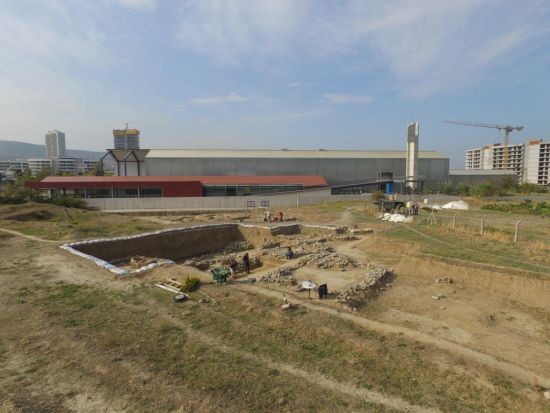
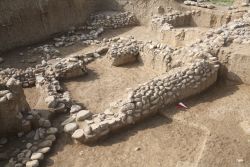 During the excavations of the IVth layer and 5-6th floors in Yesilova, only foundation remains of structures were found. After this period where tents and huts were used for housing in Yeilova, a rich process has started which we call the Renaissance of the Neolithic Age. The advancements that look place in the 3rd layer and 1-3rd floors of the Höyük, the founding of bigger residences due to population growth, in other words, the birth of a larger scale architecture is closely related to change in nutrition, which we call the life economy of huminaty. Permanent shelters and a settled lifestyle in the Yesilova Höyük only came about after a sustainable nutrition became possible.
During the excavations of the IVth layer and 5-6th floors in Yesilova, only foundation remains of structures were found. After this period where tents and huts were used for housing in Yeilova, a rich process has started which we call the Renaissance of the Neolithic Age. The advancements that look place in the 3rd layer and 1-3rd floors of the Höyük, the founding of bigger residences due to population growth, in other words, the birth of a larger scale architecture is closely related to change in nutrition, which we call the life economy of huminaty. Permanent shelters and a settled lifestyle in the Yesilova Höyük only came about after a sustainable nutrition became possible.
The IVth layer, 1st floor is known as the longest permanent settlement area of the Höyük. We have determined the existance of rectangular planned structures with stone foundations in these floors that are 1- 2 meters below the surface that represent the latest period of the Neolithic Age. These stones foundational there were built seperately and next to each other overlook a common courtyard. 5 spaces such as these were unearthed at the area. Those single room structures were built in the middle of long walls and had doors that faced the west. The spaces between the structures and the courtyard were built with strained and grounded stones. Not many remains have survived today regarding the upper structure of the stone foundation. The walls of the structures were built with mud which consisted of a mixture of clayley soil and plant remains that were put in 10-15 cantimeter molds, unlike traditional architecture which used mud bricks. Usually, on the southern parts of the structures, platforms made of mud smeared stones and kitchen workshops that were used to grind wheat. We aslo see important elements of daily life such as stone workshops that were used for making axes from serpentine stones, weaving workshops and earthenware production units. While there are small stoves inside some of the structures, the majority of the ovens are located in the courtyard thus proving that courtyards had an important place in social life.
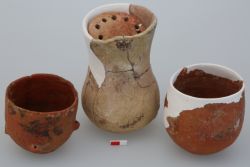 The pottery types that could be distinguished are the following: Pots with everted rims, some of which are without a neck and have circular trunks and narrowing mouths were encountered. Bowls curving outwards and with shallow bodies were encountered for the first time in this phase. Among other forms of objects, pots with straight waists, pots and bowls with semi-circular bodies, bowls with s-shaped profiles should be cited. The paste of these potteries come in brown or cream colors and their surface has a slip.Recipients in stone are one of the outstanding group of finds in the Layers IV.6-8. Fragments of bowls and pots carved in marble with their rims in very simplified forms point at an advanced level of stone workmanship.
The pottery types that could be distinguished are the following: Pots with everted rims, some of which are without a neck and have circular trunks and narrowing mouths were encountered. Bowls curving outwards and with shallow bodies were encountered for the first time in this phase. Among other forms of objects, pots with straight waists, pots and bowls with semi-circular bodies, bowls with s-shaped profiles should be cited. The paste of these potteries come in brown or cream colors and their surface has a slip.Recipients in stone are one of the outstanding group of finds in the Layers IV.6-8. Fragments of bowls and pots carved in marble with their rims in very simplified forms point at an advanced level of stone workmanship.
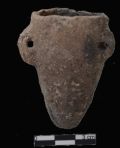 IIIrd Layer (Levels 1-2) Calcolithic period (Level 1:4340-4230B.C.): IInd Layer, This layer dates from the Chalcolithic period and is separated into two distinct settlements during two different periods, none of which cover the entire area of the mound. It could be seen that holes 6-8 meters in diameter and 1 meter in depth were opened within the Neolithic period levels and they were settled during two different ages. The Calcolithic society lived, in all probability, in houses which had their floor surfaces laid in a hole below the ground and which were constructed by means of tree branches and weeds. Due to the rapid deterioration stemming from natural causes attributable to field conditions in the area, it was not possible to detect traces of wood. Only the heaps of ash on the floors of the premises, remnants of bygone fires, could reach our day. It was observed that the Calcolithic settlement in the pattern of houses built within cavities in the ground extend in a loose tissue from north to southeast.
IIIrd Layer (Levels 1-2) Calcolithic period (Level 1:4340-4230B.C.): IInd Layer, This layer dates from the Chalcolithic period and is separated into two distinct settlements during two different periods, none of which cover the entire area of the mound. It could be seen that holes 6-8 meters in diameter and 1 meter in depth were opened within the Neolithic period levels and they were settled during two different ages. The Calcolithic society lived, in all probability, in houses which had their floor surfaces laid in a hole below the ground and which were constructed by means of tree branches and weeds. Due to the rapid deterioration stemming from natural causes attributable to field conditions in the area, it was not possible to detect traces of wood. Only the heaps of ash on the floors of the premises, remnants of bygone fires, could reach our day. It was observed that the Calcolithic settlement in the pattern of houses built within cavities in the ground extend in a loose tissue from north to southeast.
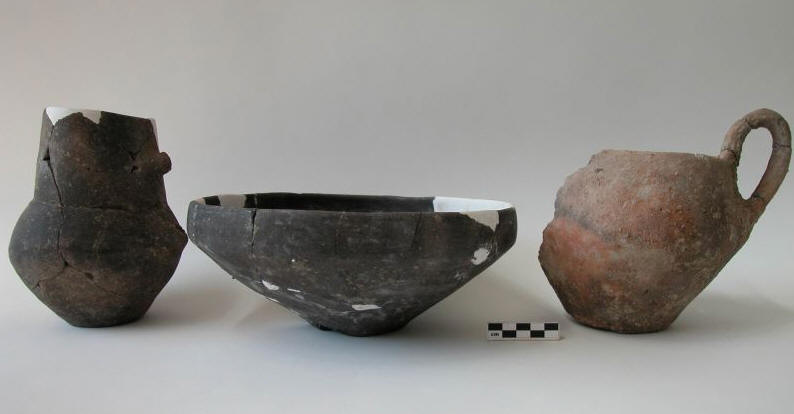 The pottery discovered in the IIIrd Layer generally bear the marks of a rather rough workmanship. In this layer, bowls with inverted rims and carineted, semi-circular pots some of which had round or elliptical handles with spurred saliencies or flat holds, pots with extraverted rims that were also thickened towards the inner space, coarse ware (cheese-pots), as well as hole-mouth pots with long necked were discovered.Yeşilova Höyük IInd Layer is dated to the Middle Calcolithic Period.
The pottery discovered in the IIIrd Layer generally bear the marks of a rather rough workmanship. In this layer, bowls with inverted rims and carineted, semi-circular pots some of which had round or elliptical handles with spurred saliencies or flat holds, pots with extraverted rims that were also thickened towards the inner space, coarse ware (cheese-pots), as well as hole-mouth pots with long necked were discovered.Yeşilova Höyük IInd Layer is dated to the Middle Calcolithic Period.
IInd Layer Early Bronze Age
Bronze Age settlement
The Early Bronze Age settlement in the Yesilova Höyük can be defined as the continuation of the Chalcolithic Age. In addition to the similarities in earthenware, the stone foundation colossal architecture points to an important development. These architectural remains pertaining to this cultural process was unearthed at Yassıtepe and the graveyard was found at the center of the Höyük. Where are houses in a part of the settlement are which is nmow the shopping center of the area.
The Early Bronze Age settlement which became modern with the oldest layer of Troy is made up of thin, long, rectangular planned structures with high stone walls. We know that there were stove spaces and platforms in those structures which as walls as high 1 meters and were stretched out as long houses along the northeast-southwest axis. The walls of the structures were built as joint walls. The structures were renovated and reused. The destruction of the walls with ans shape suggest that this 5000-year-old settlement ended with an earthquake. Civilizations what lived here after the earthquake restored the structures and continued living here. Although excavations in the area have only been going on for two years, important findings were obtained that can shed light to a period that started at the end of the Neolithic Age and ended 5000 years ago relating to the settlement in the Yesilova Höyük. Works have started tot urn the region into an exhibition area.
Ist Layer, The Roman settlement and tombs In the area of the Yesilova Höyük, we understand that there were farm houses from the Roman era that were sparsely built. Even though we have little architecture remains, a small graveyard belonging to the settlers were unearthed. We see that children were buried one by one or a grave was used for three people in the tombs that were built from bricks or stone. Coins obtained from the graves and carbon dating results point to 2-3rd century B.C. We also know that the area was not inhabited after the Roman era and the space was turned into an orchard after it was filled with alluviums.
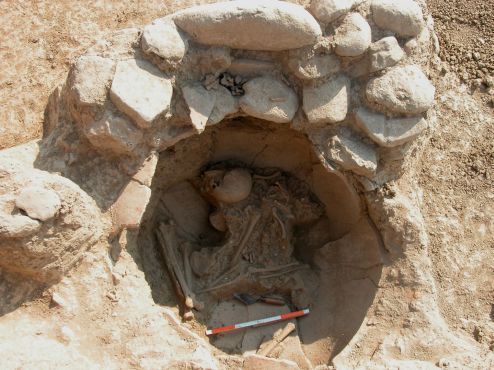
Team
Government Representative:
2008-Behçet Süzen
2009-Serçil Torlak
2010-Nur Soyer
2011-Lale Pancar
2012-Azize Karabağlı
2013-Handan Özkan (Aydın Arkeoloji Müzesi)
2014 - Ali Güçlü
2015 - Tuğba Çavuşoğlu
2016 - Mehmet Eneze, Veysel Dağ, Levşa Erdem
2017 - Elif Akgül, Yaşar Kepenek, Nur Soyer
2018 - Sevim Acarsoy, Ulaş Göçmen
2019 - Eray Aksoy, Neylan Alpay Seri, Dilara Doğu
2020 - Elif Akgül, Gökhan Yıldırım
2021 - Cengiz Arslantaş, Duygu Aydınlar
Team:
Zafer Derin, Betül Fındık, Selinay Güven , Emre Doğan, Berk Atalay, Samet Mozka, Hüseyin Mert, Zahide Karatepe, Hazel Şen, Zeynep Düşlem Çil, Müge Candoğan, Tuğçe Gökkaya, Şeyma Dilara Işık, Zeynep Çetinsoy, Ece Eren ve Günce Pelin Öçgüden, Burcu Yılmaz , Şebnem Kutlubay, Muhammet Balcı, Özlem Vatansever, Merve Gölcü, Yunus Emre, Sefa Aksoy, Yiğit Ersöz, Dilara Çolak, Merve Tuncer, Elçin Günay, Sibel Ayırkan, Burçin Uğurdan, Asiye Toprak,Yüksel Duygu, İrem Şahin, Aybüke Nacar, Elif Eryılmaz, Özge Nesritürk, Büşra Kaygın, Seyit Kaya,
Hamdi Ekiz, Ayla Ünlü, Ufuk Çetinkaya, Pınar Tunç Altun, Mehmet Işıklı, Tayfun Caymaz, Gülnur Sümer,Filiz Ay, Mehmet Yurtsever, A.Uygar Erdinç, Volkan Darıserper, Eylül Dergi, Melis Erülgen, Kerime Fındıkçı, Serdar Çetin, Nurten Hürmet, Dilara Var, Merve Demirci, Muhip Çarkı, Ozan Aydoğdu, Ali, Evren Acar, Serdar Duman, Ar.Gör. Bora Temür, Mehmet Cevher, Ayşen Çelebi, Sezen Palamutçu, Selim Voyna, Kemal Baş, Harun Reşit Şahan, Utku Saltık, Hale (Erkan) Ersoy, Yeşim Aksun, Bengisu Özgen, Banu Çelik, Övünç Körez, Hüseyin Şen, Cüneyt Serkan, Murat Öğren, Taylan Dede, Baylan Başdemir, Fulden Ayli, Gonca Özdere, Alev Boyacı, Meriç Arslan, Serap Akçay, Çiğdem Kara, Yeliz Özer, İlkay Aktan, Hatice Kuralay, Tuğçe Çetiner, Hülya Seyrekoğlu, Başak Özdemir, Derya Dalkıran,Fatma Durmaz, Beste Şenoğlu, Ali Yıldırım, Hamide Karakaş, Behiye Begüm Tütüncü, Işık Kurtman, Şahin Menteşe, Burcu Birinci, Eda Aytekin, Yağmur Yıldırım, Mehtap Öztürk, Gülcan Faika Ülvay, Kasım Öztürk Yasemin Aygün, Özcan Dursun, Dilay Demirbolat, Burcu Karaca, Nilüfer Kaçamak, Zeynep Laçin, Özge Bozkurt, Esra Aydın, Nigar Kutlu, İbrahim Hatem Çolak, Gurbet Engin, Canan Koyuncu, Meryem Kızıl, Bilge Pasin, Pırıl Dikmelik, Merve Tevkür, İrem Şükran Konuşkan , Fikret Aksoy, Gökhan Samaraz, Emre Baytan, Gökhan Baykuş, Mehmet Alabaş, Burcu Güneyli, Meltem Çatalkaya, Kübra Çayan, Cahide Gizem Tırıl, Sibel Denktaş, Menekşe Yıldız, Damla Altıöz, Burçin Kesikli, Nergis Gürses, Müyesser Çetinkaya, Eftal Ordu, Merve Çaylak, Yağmur Soydan, Kenan Muslu, Ar.Gör.Aylin Kapsız, Kaan Yıldırım, Eray Aksoy , Merve Hepiyiler , Kaan Yıldırım, Gözde Özçolak , Ece Pala, Pırıl Dikmelik ,Didem Turan , Helin Erdizer , Çağdaş Beyazdemir , Senay Sever , Gökçe Güngör, Selver Aslan , Ahu Yılda , Özge Cengiz, Gözde Tay, Tuğçe Çınar, Deniz Kurtuluş, Ufuk Doğangül, Nurcan Hacıoğlu, Ömer Cankut Atalay, Meltem Bilge, Mehmet Yiğit Toyka, Mustafa Çoban, Emre Berk Öndin, Bekir Tatar, Tuğçe Emir, Seniha Arslan, Pelin Kaçar, Esra Dursun, Belgin Yıldız, Kevser Öztürk, Taylan Taşkın, Remziye Akyol, Beza Solmaz, Cemal Koç, Ergin Tatar, Özgen Çelik, Hazel Şen, Furkan Var, Mehmet Can Ünal, Mısra Yanık, Ayberk Tüfekçi, İrem Karaarslan, Ece Eren, Yüksel Duygu Karanfil, Aleyna Tugce Bakkal ,Müge Cengiz (Mimar), Mehmet Akif Erdem, Suzan Yılmaz, Elif Külkömür, Melek Melisa İlbasan, Yekta Işık, Olcay Çetin
Aysel Arslan Diker, Ayfer Doğan, Barış Isıyel, Bilgehan Demir, Ceren Binici, Eda Kama, Eylül Tuncer,Özgür Çizer, Turgay Karalı, Elçin Erdal Karalı, M.Songül Roodenberg, Zeynep Yüce, Özge Uysal, Tanju Kaya, Serdar Mayda, Aytekin Tan, Sedef Özkan, Buşra Yağlı, Efsun Erdoğdu, Nazlı Hilal Mızrak, Salimcan Özbiliş, Berfin Parlak, Merve Altın, Ayşenur Yıldız, Nisanur Kavak, Gülcan Peker,Süleyman Kara, Senem Aktoğu, Faize Tarancı, Tülin Yıldız, Cihan Avcı,
